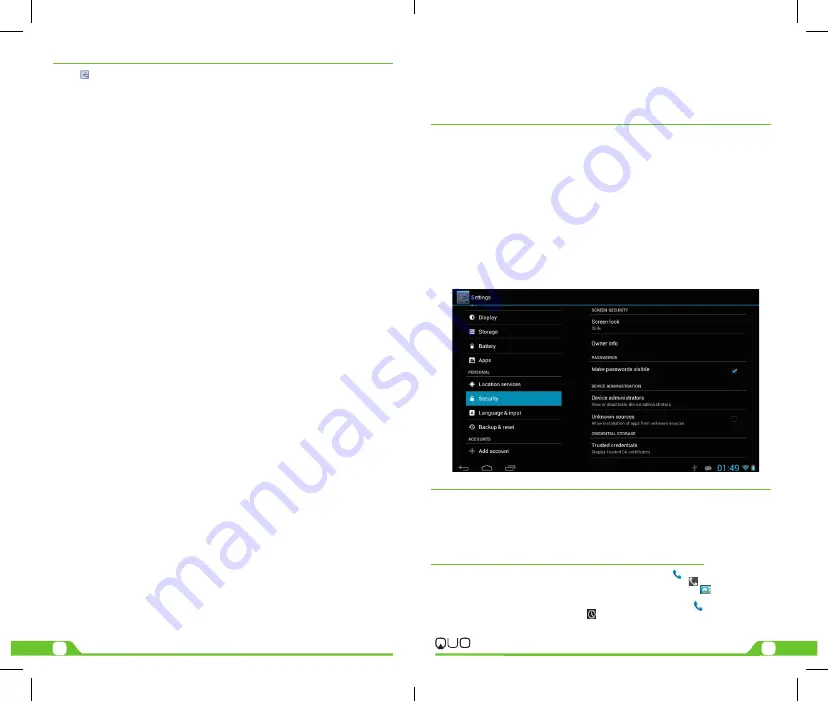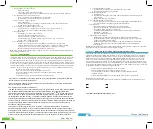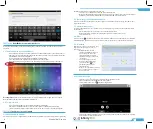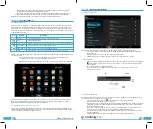
10
11
User Manual
Infinity
P
Q5
h
CHAPTER 7
Settings
The icon gives you access to a host of customizable features that each user can configure based on his/
her own individual preferences. The most frequently used features will be explained below. Please refer to the
manual in our website for a complete description of all settings.
7.1. Wireless and networks
• Wi-Fi: turn on Wi-Fi so you can see a list of available wireless networks to connect to.
• Data usage: measure the data used in a certain period of time.
• Airplane mode: enable or disable this mode if you are in an area where no electronic devices
are allowed.
• VPN (Virtual Private Network): connect to a VPN to access resources inside a secure local network,
from outside that network. To select this option, you should first choose a lock screen PIN or password.
• Portable hotspot: configure a portable Wi-Fi spot in order to share your smartphone’s network
data connections.
• Wi-Fi direct: see a list of available networks to set up a peer-to-peer connectivity.
• Mobile network: tap to enable access to data access, roaming data, use of 3G networks to save battery
or to select network operators.
7.2. 3G Internet
1. Turn off the device and plug in 3G card.
2. Turn on the device.
3. Unlock to enter into system, make sure the MID can search signal.
(Note: 3G internet can’t be used with wifi internet at the same time, the system is defaulted to use Wifi
internet. If you wish to use 3G internet, please turn off wifi internet.)
7.3. GPS Navigation
Map of the third parties is required for MID internal GPS satellite signal receiver positioning, after installation
the device can accurately implement traffic real-time navigation, meet the needs of outdoor navigation.
7.4. Device settings
•
Sound:
select the volume for music, video, games and other media, ringtones, notifications and alarms
•
Display:
select brightness, wallpaper, the autorotate option, sleep, font size, screen adaption.
•
Storage:
monitor the used and available space on your smartphone’s internal storage and on the
card.
•
Battery:
monitor the battery used when the smartphone is idle, by the display and backlight and by
the app.
•
Apps:
see all the applications that have been downloaded, that are located on the SD card, the
applications that are currently running or to view all of them.
7.5. Personal settings
•
Accounts and synchronization:
add, remove and manage your Google and other accounts.
•
Location and services:
enable Google’s location service or Location and Google search to let apps use data
from sources such as Wi-Fi and mobile networks to determine your approximate location or to let Google
use your location to improve search and other services.
•
Security:
manage screen security, passwords, device administrators and credential storage.
(See Chapter 8)
Language and input:
• Use the Language & Input settings to select the language you want to work with
on your smartphone.
• From this menu, the user can configure the onscreen keyboard and other input
methods. It is also possible to add or remove words that have been stored in the
Personal dictionary.
Backup and reset:
• enable or disable this setting to restore and backup data, passwords. (See 8.1)
7.6. System settings
Set the date and time, accessibility plug-ins, developer options and view information about your Smartphone
such as system updates, Status, Legal information, Android version and more.
•
Date and time:
check this option to allow the network to provide the time and date.
•
Accessibility:
adjust font size, enable auto-rotate screen, and speak passwords and other settings.
•
Developer options:
tap to enable the debug mode when the USB is connected, to enable the Stay
awake mode, to allow mock locations and other options.
•
User interface:
tap to select options such as Flash screen when applications do long operations, to
show visual feedback for touches, to flash areas of the screen when they update.
•
Applications:
enable the option to destroy every activity as soon as the user leaves it, to limit
background processes or to show that Apps not responding dialog for background apps.
7.7. About Smartphone
Information about the smartphone: tap for system updates, to see the status of the battery, to access legal
information about the Smartphone, to the model number, the Android version, the kernel version, the baseband
version and the build number.
CHAPTER 8
Security settings
Protect your smartphone and the privacy of your personal information by locking the screen or using data
encryption methods.
1. To secure the screen go to Applications, select Security, followed by Screen security.
Pick any of the five locking options included in the menu to unlock the screen:
•
None:
slide the lock interface and slide your finger to the right
•
Slide:
tap the lock interface and slide it to the
•
Pattern:
draw a pattern to lock the screen
•
PIN:
set up a personal identification number to unlock the screen
•
Password:
enter a passphrase to unlock the screen
2.
Encrypt smartphone:
to further secure your device, choose this option and follow the on-screen
instructions to complete the process.
3.
Make passwords visible:
tap to see the passwords as you set them.
4.
Device administration:
tap to view or deactivate device administrators or to allow installation of apps from
unknown sources
5.
Credential storage:
credentials are used to establish some kinds of VPN and Wi-Fi connections. If you
require a certificate to log on to certain networks, you should first obtain it and store it in your smart-
phone’s secure location or memory card before you can configure access to those networks.
CHAPTER 9
Back-up and reset
You can backup settings and other data associated with one or more of your Google accounts. If you need
to replace or factory reset your device, you can restore your data for any accounts that were previously backed up.
To view these settings:
1. From a Home or All Apps screen, touch the Settings icon
2. Under that, you will see several options such as Backup my data, Automatic restore, Factory data
reset or System upgrade, touch Backup & reset.
CHAPTER 10
Make and Answer Calls
Directly make a call:
On the home screen or in the All Apps screen, touch the
button to display the dialing
keypad. Touch the numeric buttons to input the telephone number and touch the
button to make the call.
Make the call from Contacts:
On the home screen or in the All Apps screen, touch the
icon, touch the
desired contact and touch the phone number to dial it.
Make the call from Call log:
On the home screen or in the All Apps screen,touch the
button, notice the
three tabs at the top of the phone, the call log tab
shows recent calls. Touch the phone icon in a call log
to return it.












